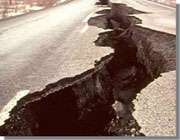Earthquake in Persia
part 3

Recourse to astrologers was common during cataclysmic occurrences, and there were also individuals who predicted earthquakes. The astrologer Abu Taher Shirazi was reported to have predicted the exact date of the earthquake that destroyed Tabriz during the night of 14 ?afar 434/3 October 1042 and killed more than 40,000 people. He was consequently chosen to direct the reconstruction of the city and announced that in the future Tabriz would no longer be in danger. Hamd-Allah Mostawfi, writing in 741/1340, noted that the prediction had proved correct (Nozhat al-qolub, ed. Le Strange, pp. 75-76; tr., pp. 78-79; Ebn al-Asir, IX, p. 513). After an earthquake at Urmia in 1300/1883 an astrologer from Tehran sent a telegram informing the population that the earth would continue to tremble for forty days. Armenian priests consulted their books and announced a new shock for the next morning at 11 o’clock. A mulla from Tabriz predicted an aftershock for the following Sunday at 2:00 p.m., which set off a panic among the population. As his prediction did not come true, the mulla was arrested (S. G. Wilson, pp. 224-25). On 21 Jomada I 1261/28 May 1845, at about four hours before nightfall, a tremor was felt 2 parasangs (ca. 14 km) from Ma?had just at the place where the European traveler J. P. Ferrier was preparing to camp for the night; his guide concluded that the tremor was a bad omen and moved the camp (Ferrier, I, p. 260).
In such a situation of permanent danger it is paradoxical that no systematic adaptation of traditional Persian construction techniques to the frequency of earth tremors has been attempted, at least until very recently (Ambraseys and Melville, p. 25).
After the great earthquake of 1194/1780 at Tabriz the inhabitants began to build their walls as low as possible, using wood instead of brick and stucco, and to roof the bazars with planks, rather than with domes (Morier, pp. 278-79). Nevertheless, in 1232/1817 they again rebuilt the city walls to a considerable height (Johnson, p. 212). In the same city it was apparently Westerners in the service of the crown prince Abbas Mirza (q.v.) who first introduced construction methods that provided a certain security, particularly wood-frame structures with flexible joints (known as taktapush);
while such methods seem to have been reserved for temporary shelters in gardens (Ker Porter, II, p. 502), the old houses were rebuilt in the traditional fashion. After the earthquake of 1288/1871 at Qucan a new type of emergency shelter appeared: beams removed from the ruins were assembled in “A” frames or used as ridge poles, the walls being plastered with earth (MacGregor, II, pp. 85-86). When such a house had to be enlarged, an identical building was constructed parallel to the first and the space between enclosed with walls and covered with a flat roof. Houses of this type, consisting of one to three rooms, withstood the earthquakes of 1311/1893 and 1313/1895 and were still in place in 1322/1904 (Huntington, p. 236, pl. 27). But these ephemeral improvements do not seem to have had any long-term impact. In the 1960s there were private attempts in the comfortable neighborhoods of northern Tehran to bring spherical houses, already ill-adapted to the sloping terrain, up to antiseismic standards (Ambraseys and Melville, pp. 25-26, pl. 26), but no official regulations were ever adopted. In fact, Persia, which includes some of the most seismically active regions in the world, seems never to have been seriously concerned about the danger and the need for preventive measures. Daily life is marked by indifference and appears not to have been noticeably affected by major episodes. The historical repercussions have been none the less significant, particularly for the fates of certain cities. The decline of Qumes in the 9th century, of Siraf in the 11th, and of Nishapur after the 12th-14th centuries seems to have been largely owing to destructive earthquakes (Ambraseys and Melville, p. 109).
Source: enclopedia.thefreedictionary.com
Other Links:
Geography and History, Zanjan
Persian Eagles: Part 1
Persian Eagles: part 2